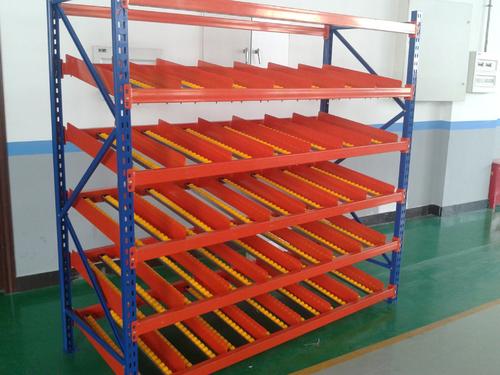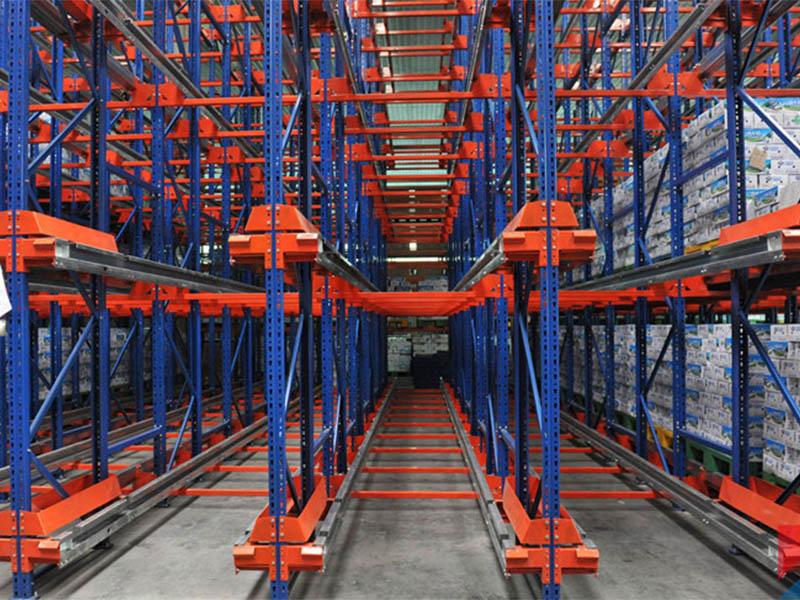In the relentless pursuit of warehouse efficiency and cost reduction, maximizing available space is paramount. Enter the mobile racking system, a revolutionary storage solution that transforms static aisles into dynamic, high-density configurations. Unlike traditional fixed racking, a mobile racking system literally moves, eliminating wasted aisle space and dramatically increasing storage capacity within the same footprint. This article delves deep into the mechanics, benefits, applications, and considerations surrounding this powerful warehousing technology.

Understanding the Core Principle: How a Mobile Racking System Works
At its heart, a mobile racking system operates on a simple yet ingenious principle: instead of multiple fixed aisles between rows of racks, the racks themselves are mounted on electrically powered carriages that glide along embedded floor rails. Only one operating aisle is required at any given time. When access to a specific product or pallet location is needed, the operator activates the system (typically via a control panel or wireless remote), causing entire rows of racks to move laterally along the rails. This movement creates a temporary access aisle precisely where it's needed.
The key components enabling this movement include:
Base Carriages: Robust, motorized units mounted under each racking row, equipped with wheels and drive mechanisms.
Guide Rails: Precision-engineered tracks embedded flush into the warehouse floor, providing a smooth and stable path for the carriages.
Drive System: Electric motors (often 24V DC for safety and efficiency) powering the movement, usually controlled by a centralized management system.
Safety Systems: Critical features like aisle-end safety barriers, motion sensors, photoelectric light curtains, audible alarms, and emergency stop buttons ensure personnel safety during operation. Anti-tilt devices prevent rack movement if overloaded or unbalanced.
Control Interface: User-friendly panels or wireless remotes allowing operators to command rack movement safely and easily.
This innovative approach means that up to 80% of the floor space previously dedicated to permanent aisles can now be utilized for storage. A mobile racking system essentially compresses multiple static aisles into a single dynamic one.
Unlocking Unprecedented Space Utilization: The Density Advantage
The most compelling and defining benefit of a mobile racking system is its unparalleled ability to maximize storage density. Traditional pallet racking layouts require wide aisles (often 3 meters or more) to accommodate forklift maneuverability. These aisles represent significant "dead space" that doesn't store any product.
Density Gains: A mobile racking system typically reduces the number of aisles by 50-80% compared to conventional systems. This translates directly into a proportional increase in storage positions within the same warehouse footprint. Warehouses can often double or even triple their pallet storage capacity without expanding the building.
Optimizing Cubic Space: By concentrating the storage footprint, a mobile racking system allows for more effective use of the warehouse's vertical space. Higher bay heights become more practical and efficient.
Cost per Pallet Position: While the initial investment is higher than static racking, the dramatic increase in storage positions significantly lowers the cost per pallet position over the system's lifespan. This makes a mobile racking system highly cost-effective for expensive real estate.
Footprint Preservation: For facilities where expansion is impossible or prohibitively expensive (urban locations, historical buildings), a mobile racking system offers the only viable solution for significantly increasing capacity.

Operational Efficiency and Workflow Considerations
While density is king, operational impact is crucial. Implementing a mobile racking system changes workflow dynamics:
Sequential Access: Access is sequential, meaning only one aisle is open at a time. This requires disciplined stock location management (e.g., WMS integration) and workflow planning to minimize unnecessary movement and potential bottlenecks during peak times.
Cycle Time Impact: Retrieving a pallet involves the time to move the racks plus the time for the forklift to enter, retrieve/replenish, and exit. While the movement time is usually short (seconds to tens of seconds), it adds overhead compared to instantly accessing a static aisle. Efficient location planning minimizes this impact.
Warehouse Management System (WMS) Integration: Integration with a robust WMS is highly recommended, if not essential. The WMS optimizes put-away and retrieval sequences, grouping tasks within the same aisle to minimize rack movements. It provides real-time location data crucial for efficient operation.
Suitable Workflows: Mobile racking systems excel in lower-turnover environments, cold storage (where space is extremely valuable and temperature loss must be minimized), or for storing large quantities of similar items (SKU consolidation). They are less ideal for highly dynamic, fast-paced picking operations requiring constant, random access across many SKUs.
Safety: The Non-Negotiable Foundation of Mobile Racking
Safety is paramount in any warehouse, but it takes on heightened importance with a moving mobile racking system. Comprehensive safety features are integral to the design and operation:
Aisle Access Control: Physical barriers (gates) at aisle ends prevent personnel or equipment from entering an aisle while racks are moving or adjacent racks are moving to create an aisle.
Motion Sensors and Light Curtains: Sensors detect any obstruction within the moving path or the newly created aisle, immediately halting movement to prevent collisions.
Audible and Visual Alarms: Clear warning signals (alarms, flashing lights) alert personnel before and during rack movement.
Emergency Stop Buttons: Easily accessible E-Stop buttons allow immediate shutdown of the entire system in case of any hazard.
Anti-Collision Systems: Prevent adjacent rows from moving simultaneously towards each other.
Anti-Tilt/Tip Protection: Devices ensure the racks are stable and prevent movement if the load is uneven or exceeds capacity, or if seismic activity is detected.
Lockout/Tagout Procedures: Essential for maintenance work on the system.
Comprehensive Training: Operators and warehouse personnel must receive thorough training on safe operating procedures, emergency protocols, and hazard recognition specific to the mobile racking system.
Regular safety audits and strict adherence to protocols are mandatory. A safe mobile racking system environment requires a strong safety culture.
Investment Analysis: Costs, ROI, and Long-Term Value
Implementing a mobile racking system represents a significant capital investment. Understanding the cost structure and potential return is crucial:
Higher Initial Cost: A mobile racking system costs significantly more per linear meter than standard static pallet racking. This premium covers the motorized bases, complex control systems, safety features, and specialized installation (including floor rail embedding).
Floor Preparation: The warehouse floor must be exceptionally flat, level, and possess sufficient load-bearing capacity to support the concentrated loads of fully loaded racks moving on rails. Significant concrete work (grinding, leveling, potentially reinforcement) is often required, adding to upfront costs.
Infrastructure: Adequate electrical supply for the drive motors and control systems needs to be installed.
Calculating ROI: The compelling ROI argument lies in the dramatic increase in storage capacity:
Reduced Real Estate Costs: Avoidance of costly warehouse expansion or relocation.
Lower Construction Costs: Cheaper than building a new warehouse extension.
Operational Savings: Potential energy savings (especially in cold storage due to reduced air volume), reduced material handling equipment needs (potentially fewer forklifts), and lower per-pallet storage costs over time.
Total Cost of Ownership (TCO): While the upfront cost is high, the TCO over 15-20 years, factoring in the massive space savings, often makes a mobile racking system the most economical solution for high-density storage needs. Maintenance costs (servicing motors, safety systems) should also be factored in.
Implementation and Suitability: Is Mobile Racking Right For You?
Successfully deploying a mobile racking system requires careful planning and assessment:
Ideal Applications:
Cold storage facilities (maximizing expensive refrigerated space).
Archives and document storage.
Storing bulky, low-turnover items.
Warehouses with severe space constraints or high real estate costs.
Storing large quantities of the same SKU (high pallet-in/pallet-out).
Key Suitability Factors:
Turnover Profile: Best suited for medium-to-slow moving inventory (FIFO or LIFO compatible).
Floor Condition: Requires a very high-specification floor (flatness, levelness, load capacity). Assessment and potential remediation are essential early steps.
Building Structure: Must withstand the dynamic loads of moving racks. Structural engineering assessment is mandatory.
Budget: Sufficient capital budget for the higher initial investment and potential floor work.
Operational Discipline: Requires strong processes, WMS integration, and staff adherence to safety protocols.
Implementation Process:
Feasibility Study: Detailed analysis of needs, costs, ROI, floor, and building suitability.
Design & Engineering: Custom design based on inventory profile, pallet specs, building dimensions, and seismic requirements. Structural sign-off.
Floor Preparation: Execution of necessary floor leveling, reinforcement, and rail embedding.
Installation: Installation of rails, carriages, racking uprights, beams, and safety systems by specialized technicians.
Integration: Connecting the control system and integrating with the WMS.
Testing & Commissioning: Rigorous testing of all functions and safety features.
Training: Comprehensive training for warehouse staff, managers, and maintenance personnel.
Go-Live & Support: Phased implementation and ongoing support.
The Future of Mobile Racking: Automation and Integration
The evolution of the mobile racking system continues, driven by broader warehouse automation trends:
Integration with AS/RS: Mobile racking rows are increasingly being integrated with automated storage and retrieval systems (AS/RS), such as miniload cranes or shuttle systems operating within the single dynamic aisle. This creates highly dense, fully automated storage blocks.
Enhanced Control Systems: Smarter control software utilizing AI and machine learning to further optimize movement sequences, predict maintenance needs, and integrate seamlessly with broader Warehouse Execution Systems (WES).
Improved Energy Efficiency: Development of more energy-efficient motors and regenerative drive systems.
Advanced Safety Technologies: Incorporation of AI-powered vision systems for enhanced obstacle detection and predictive safety.
The mobile racking system stands as a powerful testament to engineering ingenuity in solving the perennial warehouse challenge of space scarcity. By transforming fixed aisles into dynamic pathways, it unlocks unprecedented storage density, offering a compelling solution for facilities constrained by footprint or seeking significant operational cost savings through optimized space utilization. While requiring a higher initial investment and careful consideration of workflow, safety, and suitability, the long-term return on investment, particularly in terms of cost per pallet position and avoidance of expansion costs, is undeniable. For warehouses storing medium-to-slow moving inventory, especially in cold storage, archives, or high-value real estate locations, implementing a robust and well-integrated mobile racking system remains one of the most effective strategies for maximizing storage potential and driving warehouse efficiency into the future. As automation advances, the role of the mobile racking system as a foundational element in ultra-high-density automated storage is set to grow even further.







